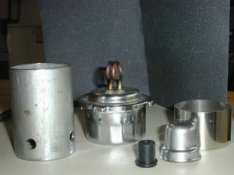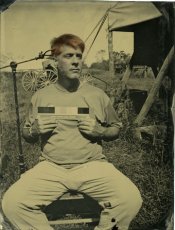Robert, with big events/big workflow I guess that's just the way things were back then, but how much was a penny worth to a struggling, often itinerant photographer? 20 people = 20 pennies?!
The main exception, to my mind, would be a plate that would be ruined by varnishing it, as explained earlier. The term "in the bright" after all has entered into the vernacular - if it wasn't a commonplace thing, I'm not sure that it would have become so widely an accepted practice and one that would warrant it's own by-line.
Chloroform is indeed a small amount in the original sandarac formula, but there may have been a good reason for it. Sometimes the alcohol content of the varnish attacks the collodion. I believe this is partly the reason why some people warmed the plate - the excess alcohol in the varnish was driven off by the heat before it had any deleterious effects. George Berkhofer cautions against warming the plate to just bloodheat for this reason - others say "uncomfortably hot to hold." Perhaps that is why Kendrick uses a blowlamp? (I did try that, but cracked many plates, burnt my hand and singed all the hairs on my forearm off!) Maybe the chloroform content counteracted this - I don't know. I do know that the amber formula relies on the solvent effect of chloroform and ether to firstly dissolve the amber and secondly to evaporate quickly leaving a thin, hard amber film behind - one that could have been cased immediately. It may be just my bad luck, or bad chemicals (bearing in mind that, at worst, we are talking about people who used water from puddles and chemicals whose purity doesn't even come close to those we use today - the water content of collodion being a prime example when the ether/alcohol mix used to dissolve guncotton was highly questionable), but the sandarac formulas I have used do not fully harden with heat - they take time as well. I've had stacked plates stick to each other, and I know others have, to.
If you want to try a sandarac varnish with chloroform, Towler's 1864 masterpiece has this formula (note that it is a cold varnish):
"The following varnish is used on the cold plate, is very hard when dry, and is not softened at a high temperature when printing.
Gum sandarac, 4 ounces.
Oil of lavender, 3 ounces.
Alcohol, 28 ounces.
Chloroform, 6 drachms.
Digest, dissolve, and decant as usual."
Note that he doesn't say that it becomes hard immediately, which would have probably precluded it from events when people wanted to take the image away with them - probably!
Regards,
Neil.




 BUT I have an excuse. I can make a beautiful portrait of her beloved son. Yep, that's it!
BUT I have an excuse. I can make a beautiful portrait of her beloved son. Yep, that's it!

